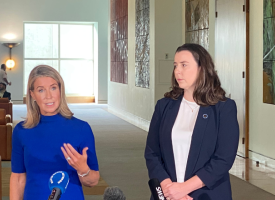Short- and long-term healthcare reform needed
Quotes can be attributed to Dr Michael Lumsden Steel, spokesperson AMA Tasmania

AMA Tasmania welcomes the release of the report into the State Hospitals Emergency Departments and issues affecting patient flow throughout the health system, which is evidenced through ambulance ramping and patients waiting too long in our emergency departments before being admitted or sent home after treatment.
The AMA met regularly with the primary author of the review Ms Deb Picone to be updated on progress, however, today is the first time we have seen the final report.
While acknowledging the government's efforts to engage with stakeholders and showing a clear understanding of the significant challenges facing emergency departments, Dr Michael Lumsden Steel added, "some of the recommendations are overly ambitious, some only go so far in addressing critical areas such as staffing challenges, and some serious pressure points for our healthcare system have been completely overlooked.
Ask any emergency department doctor about their biggest frustration, and they will tell you it is getting patients admitted into an in-patient bed. Ask any hospital physician, and they will tell you it’s not having appropriate sub-acute care beds to move patients into to free up acute beds for the unwell stuck in emergency departments. The human toll of bed blocks is a daily reality they grapple with.
"Frustratingly, nearly 10% of the total statewide hospital acute bed capacity is occupied by patients needing aged care or NDIS services without appropriate placement options. That’s 148 beds that could be freed up tomorrow if there was the appropriate place to move these patients.
"To alleviate the strain on hospital bed capacity, immediate steps must be taken to increase nursing and medical support to residential aged care services, improve NDIS services, and establish integrated primary health care services for individuals with chronic and complex physical and mental health conditions.
“The government needs to focus significantly on subacute and frailty care, including bringing forward the building of a new subacute facility at St John’s Park.
“The urgency of freeing up beds cannot be overstated. Many of these sub-acute patients could be stepped down into temporary care facilities while building of a new facility takes place.
“We note that issues surrounding aged care and NDIS, from workforce shortages to financial sustainability, are issues primarily for the federal government, but the state can help too in various ways. What we don’t want is more finger pointing and inaction.
“Where the review has fallen short is overlooking areas of critical shortage of various types of beds and services in Tasmania. For example, while the report acknowledges the importance of expanding the Hospital in the Home or GEM@home programs, (we need at least 100 more spots), it failed to address the implementation of specialised geriatric care in the hospital, a significant oversight given that Tasmania has the highest population of older people in Australia.”
AMA Tasmania has put forth a comprehensive plan for subacute and low acuity care implementation. This includes the use of supplemented bed in Medi-hotel environments with recruitment and retention of appropriate staffing, utilisation of community hospitals' subacute beds, and support for patients in their homes by other community health providers.
The review fails to highlight the critical role of all staff in managing patient flow within our healthcare system while also exposing deficiencies in several key areas. These shortcomings include inadequate capacity to manage tests, results, and patient reviews, as well as insufficient staffing across key hospital departments across the state. We cannot afford to focus on flow management and staff governance without emphasising operational aspects to ensure effective and efficient healthcare delivery.
“Expanding the scope of practice of other healthcare providers is not the panacea. AMA Tasmania must be involved in any decisions about changes to clinical care provided by other healthcare providers and not doctors. Doctors are highly trained and cannot be substituted by other healthcare providers without increased patient risk. However, where key integrated areas of delivering healthcare in Tasmania work together for instance, Ambulance Tasmania identifying areas where there might be safer and more efficient ways to deliver care to Tasmanians are welcomed.
Record-long wait times for planned surgeries and ongoing challenges in emergency departments underscore the urgent need for action. Access and affordability issues in primary care further exacerbate the situation, with the recent announcement of several key general practices across the state closing or amalgamating adding to the pressure, requiring an improved model of better employment conditions for general practice trainees, funding rebates for patients and improved workforce planning.
The AMA renews our call to the state government to collaborate with the commonwealth to expedite necessary reforms and allocate resources, identify the funding gap, and agree on a plan to fix it. We need to shine the light on where the deficiency is and come up with a plan as to how we can fund those deficiencies. This is crucial to ensure the delivery of high-quality and accessible healthcare services to all Tasmanians. The complexity of our healthcare system's challenges necessitates more robust measures.
“The only way to fix our emergency departments is to address health system capacity and patient flow through honest collaboration, innovation, and investment to meet current and projected demands.”>>>



